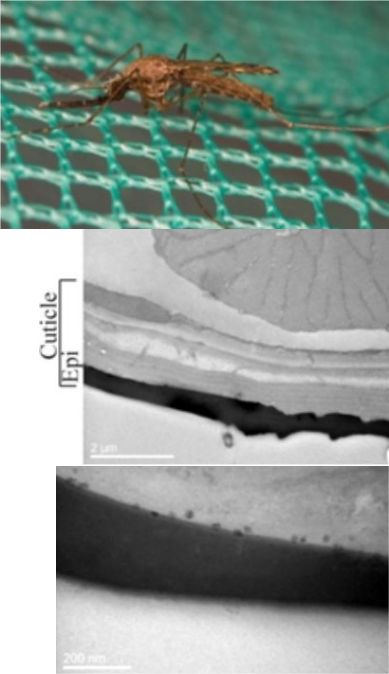Description
Material provided: Summary report on levels of cuticular hydrocarbons (CHC) (ngr hydrocarbons/mg of mosquito)
Unit definition: 3 replicates x 30-40 mosquito specimens/ population or strain
We employ specialized GC-MS analysis for quantification of CHCs, a critical determinant of cuticle thickness, to explore the presence of the trait in mosquito populations.
Description
Cuticle thickening by enriched deposition of CHCs was recently reported as a mechanism that slows down the penetration rate of pyrethroids, thus contributing to penetration resistance and possibly broadening the insecticide resistance phenotype.
We employ specialized GC-MS analysis for quantification of CHCs to determine the presence of the trait in insecticide resistant mosquito populations compared to susceptible ones (all populations, resistant and susceptible, are provided by the user; when calculate Units, please also include Susceptible/control).
Use of the service will provide sufficient information for several research questions on cuticular changes that could be associated with insecticide resistance phenotypes observed in mosquito populations. Additional specific ecological questions can be possibly addressed by this marker.
The experiment and the product
The user should provide mosquito samples (lab strains or field-caught) appropriately prepared and stored (see Appendix 1). Consultancy on sample preparation (technical and biological tips, depending on research questions) will be provided by the TNA operator.
We will handle and analyze the samples provided by the user with the following workflow:
Step 1: Extraction of lipids using appropriate organic solvent protocols, separation and quantitation of total CHCs by appropriate analytical techniques.
Step 2: Analysis of data and preparation of reports to be returned to the user.
In each step, relevant assurance quality procedures will be followed and appropriate control samples will be used.
Data layout
The data returned to the user will consist of both raw data and summary tables or figures reporting CHC levels and species of the mosquito populations analyzed.
Publications
- Balabanidou V, Kampouraki A, MacLean M, Blomquist GJ, Tittiger C, Juarez MP, Mijailovsky SJ, Chalepakis G, Anthousi A, Lynd A, Antoine S, Hemingway J, Ranson H, Lycett GJ, Vontas J (2016) Cytochrome P450 associated with insecticide resistance catalyzes cuticular hydrocarbon production in Anopheles gambiae Proc Nat Acad Sci USA (PNAS) 113, 9268-9273
For more information, please contact us.
Appendix 1
Preservation of mosquito specimens in aluminum foil for CHC quantitative analysis
Procedure
-
- Collect mosquitoes of the same age, gender and feeding status (for example 3-5 day-old females, sugar fed only), kill them (i.e. place them for a few minutes at – 200 C) and them let them dry for 2-3 days at Room Temperature.
- Place 5-10 dried mosquitoes in aluminum foil (i.e make small baskets or molds using the top of a 15-ml falcon tube) and wrap them very carefully closing only the top of the aluminum foil basket. Very important is not to melt the mosquitoes inside the basket. 30-40 mosquitoes (needed for each analysis) x 3 biological replicates per population or strain, to obtain publishable data sets.
- Store samples at Room temperature and ship them as soon as all samples are collected to the Service Provider.

